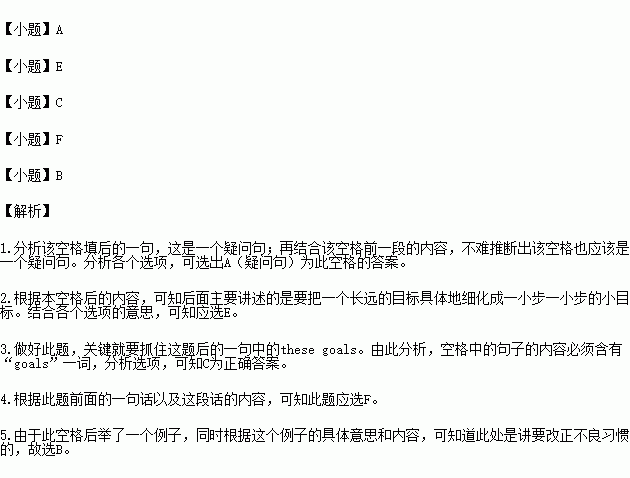题目内容
根据短文内容,从短文后的七个选项中选出能填入空白处的最佳选项,选项中有两项为多余选项。
According to statistics published by the University of Scranton,about 45 percent of Americans usually make New Year’s resolutions------and the most popular resolution is losing weight. Of those who make resolutions,a mere 8 percent achieve them.
___1.___ Are we just setting ourselves up for failure? Learn how to make realistic resolutions and how to overcome the roadblocks along the way.
Setting a resolution to lose pounds isn’t a goal that’s achievable now. It may be a good long-term goal. ___2.___ Registered dietitian Elisa Zied says”… to be real when you make a resolution. It’s okay to shoot for the stars like making a resolution,but why not set a smaller goal and train smart?”
The same concept applies to weight loss. ___3.___ These goals should help develop healthy habits that will finally help achieve your long-term resolution.
Notice that these goals are simple and achievable. “Instead of going from zero to 60,from never going to the gym to going four to five times a week,why not start with three days a week,get consistent and build from there,” Zied says. Set yourself up for success and map out your course by making appointments with yourself to be active. ___4.___
You also need to be aware of your current exercise and eating habits to make achievable goals. Keeping a diary of your food and exercise habits can help. Record everything you eat and drink for three to five days and review it. ___5.___For example,if you notice a tendency to snack on unhealthy fare,set a goal to eat a fruit or vegetable with each snack. Building on these smaller goals over time can help you achieve your long-term goal.
A. So why do so many of us fail to achieve our goals?
B. Once you notice your not-so-good habits,start fixing them.
C. Set between one to three weekly goals that you want to achieve.
D. Resolutions usually involve a commitment to sticking to your goals.
E. However,in order to reach it,you need to take baby steps to get it down.
F. If you treat your goals like set appointment,you’re more likely to achieve them.
G. Losing weight,as well as getting a better job,is among the most popular resolutions for adults.

